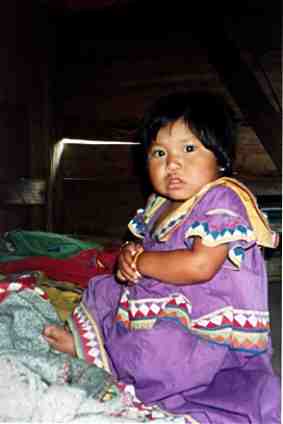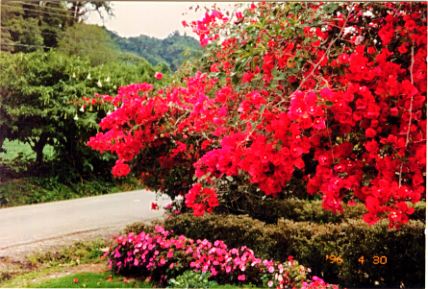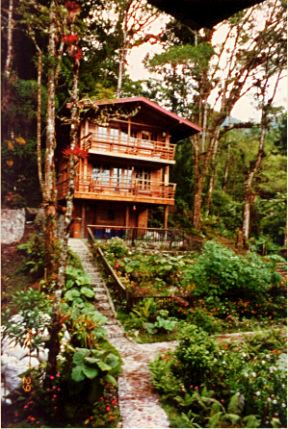

Primeval rainforests bedecked with clouds, noisy, chattering birds flash brilliant iridescent colors as they dart about their daily chores, flowering epiphytes bloom en masse high above the forest floor while gurgling streams glisten and tumble hurriedly over great boulders in their dance towards the sea. This enchanted land is the Chiriqui Highlands, the part of the Cordillera Central that defines the northern border of the province of Chiriqui. It is a beautiful landscape of cloudforests, volcanic peaks, coffee plantations and home to most of Panama's Guaymi Indians. Topographically, the Cordillera Central spreads from Costa Rica through the western portion of Panama like a jagged spine that separates the northern provinces from those of the south. It is on the lower southern slopes and plains that Panama's population is concentrated and along which runs the Pan American Highway. In the province of Chiriqui, a few roads link the highway to the highland areas and only one extends through the mountains to the northern coastal town of Chiriqui Grande. All of these roads comprise the most scenic to be found in Panama. Lowland areas give way to gentle rolling hills that have been cleared for agriculture and pastureland. Climbing further, mountains become steeper, their slopes more densely forested and by noontime, they are enveloped in clouds that change their color from verdant green to misty blue.
La Amistad International Park
 |
Guaymi Baby in Traditional Dress Photo Courtesy of Los Quetzales |
The usual access to La Amistad International Park is at the Cerro Punta guard station. However, park attendants are not always available and a more pleasant option is further up the road at Guadalupe. You will know that you have reached Guadalupe when you see the flowers. Beds of white lilies, massed blue agapanthus, rows of fragrant roses, drifts of impatiens and a dazzling array of annuals bring color and vibrancy to this tiny mountain village at the end of the La Concepcion-Cerro Punta road. Panamanians from the lowlands come to buy flowers on the weekends and birds of paradise are grown for export to Europe in the rows of hot houses along the road past Cerro Punta. Cattle and horses graze in the verdant fields of the lower valleys while vegetables are grown on the slopes. The only blemish to this captivating landscape is the use of white PVC pipes for irrigation. They run up and down the sides of the mountain between the rows of lettuce, broccoli, potatoes, onions and green peppers. From Guadalupe, it is a one hour hike into La Amistad through the private property of Los Quetzales.
Volcan Baru
 |
Flowers in Guadalupe |
The easiest way to reach the peak is simply to drive up from Boquete in a 4WD vehicle. This can be rented in David or you can hire a driver and vehicle in Boquete or Cerro Punta. Hiking up to the peak and back takes about 12-14 hrs. from Boquete or Volcan and it is recommended that you plan to camp for a night. Locals say that the most stunning vista is to be seen at dawn when the Pacific and the Atlantic are presented against the backdrop of a sun-drenched morning sky.
Everything that you choose to do in the Chiriqui Highlands is a delight. Exploring by car, you will drive along a seemingly misty Alpine pasture and around the next curve, the banana plantation will remind you that you are actually in Panama and not Switzerland. Hiking trails abound for indigenous peoples have lived in these valleys long before roads ever existed. Numerous rivers provide the opportunity for rafting on thrilling Class III and Class IV rapids but my favorite pastime is to find a quiet spot on a nearby boulder. Birds stop for a drink in the quiet pools by the banks and water droplets catch rays of light, flashing glints of color in the sunshine. The air is cool and sweet and I am satisfied with the quiet adventures of the soul.
Best Times to Go:
For hiking, the "dry" season from January to April is best. It is never really dry in the Chiriqui Highlands, but rather, less wet. May to November is considered to be the rainy season and rivers become swollen giving rise to the Class IV rapids sought by intrepid rafters. Bird lovers will want to visit from February to May during the breeding season of the Quetzals, one of the most beautiful birds in the world.Getting There:
From Costa Rica by car, the Chiriqui Highlands are just across the border. If you have the time, it is a very pleasant 7 hr. drive from the city of Panama to David through an interesting and varied terrain. Schedule another two hours from David to Boquete or Cerro Punta. Plan your trip so that you do not drive into the Chiriqui Highlands at night. You will not want to miss the most entrancing scenery in Panama. Buses are available but take longer and their schedules will require that you spend a night in David before traveling to the Highland areas. For those with limited time, it is easier to fly from the city of Panama to David where you can rent a car or make arrangements to be picked up at the airport. |
Hummingbird at Los Quetzales |
Clothing/Gear:
Comfortable clothing, jacket, rainwear, umbrella, good walking shoes, compass, maps, first aid kit, bottled water and a Swiss Army knife. Additionally, for camping on the volcano, you will need to bring a tent, the usual camping equipment, fleece jacket and pants, windproof and waterproof shell and a flashlight. At 3475m (11,400 ft.), Volcan Baru can become quite cold especially in the wind and rain.General Information:
Unless you plan to camp out for your entire trip, it is a hassle to lug camping equipment just to spend a night on the volcano. Another option is to hike up to the peak and arrange to be met there by a vehicle. The hike from Cerro Punta (about 6-7 hrs.) is shorter than from Boquete or Volcan (about 8 hrs.) so if you start early, it may be possible to reach the peak before the clouds obstruct the view.Rafting expeditions usually take place on weekends and require a minimum of four people. If you are traveling solo, it is a good idea to put in your reservations as soon as you arrive in Panama or before you leave home if your visit is short. Arrangements must be made in advance since the rafting outfitters do not have business offices in the Chiriqui area. All other bookings may be made with only a day's notice if you are traveling at whim except during holidays.
Assuming double occupancy, plan on spending about $35-50 per person per day for a room and three meals. You may negotiate locally for a guide who charges about $10 per day. A guided hike up Volcan Baru or the Cerro Punta-Boquete trail with pick up at the end of the hike costs about $50 while a one day rafting trip costs about $100. Los Quetzales charges $5 per person for those wanting to visit La Amistad International Park through their property. The price includes a local guide who will accompany you for a few hours and you can purchase a picnic lunch at the hotel's restaurant to take with you.
Planning Tips:
 |
Cabin at Los Quetzales |
Important Resources:
Los Quetzales will make all arrangements for guided hikes: Cerro Punta to Volcan Baru with pick up at the peak, Cerro Punta to Boquete with pick up in Boquete, and Cerro Punta to the high pass on the Cerro Punta-Boquete trail and back (half day). They will also make reservations for river rafting, horseback riding and visits to nearby hot springs.
Related Books:

© copyright 1996 Adventures Great and Small